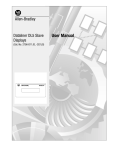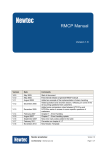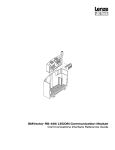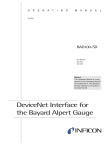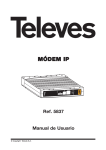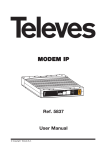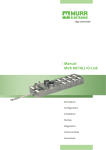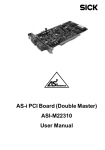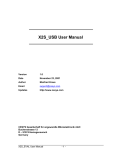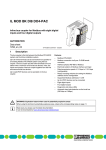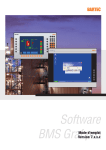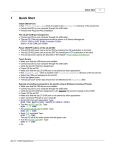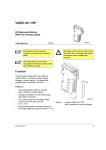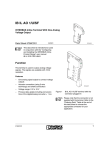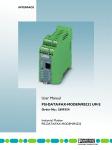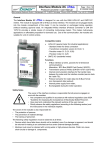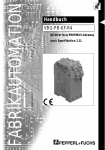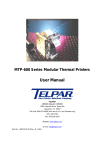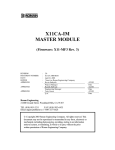Download AS-i Master RS 232C ASI
Transcript
AS-i 2.1 AS-i Master RS 232C ASI-M11320 User Manual AS-i Master Table of Contents issue date 21.11.2001 Table of Contents 1 The Used Symbols ................................................................................... 5 2 Safety ........................................................................................................ 7 2.1 2.2 Intended Use ........................................................................................................... 7 General Safety Information .................................................................................... 7 3 General Information ................................................................................. 9 4 Connections, Displays and Operating Keys ........................................ 11 4.1 4.1.1 4.2 4.2.1 4.3 4.3.1 Power Supply Concepts and AS-i Connection Techniques ............................ 11 Single Masters in IP20 with AS-i Power Supply ..................................................... 11 The Serial Interfaces ............................................................................................. 12 AS-i Master with RS 232C ...................................................................................... 12 Display and Operating Elements ......................................................................... 13 LEDs of the Single Masters .................................................................................... 13 5 Operating the AS-i Master ..................................................................... 15 5.1 5.2 5.3 5.3.1 5.3.2 5.4 5.4.1 5.4.2 5.5 5.5.1 5.5.2 5.6 Master Start-Up ..................................................................................................... 15 Configuration Mode .............................................................................................. 15 Protected Operating Mode ................................................................................... 16 Switching to Protected Operating Mode ................................................................. 16 Configuration Errors in Protected Operating Mode ................................................. 16 Assigning an AS-i Address in Configuration Mode .......................................... 17 Assigning a Slave Address ..................................................................................... 17 Erasing the Slave Address ..................................................................................... 17 Programming the Address in Case of Configuration Errors ............................ 18 Automatic Address Assignment .............................................................................. 18 Manual Address Assignment .................................................................................. 18 Error Messages ..................................................................................................... 19 6 Advanced Diagnostics for AS-i Masters .............................................. 21 6.1 6.2 6.3 List of Corrupted AS-i Slaves (LCS) ................................................................... 21 Protocol Analysis: Counters of Corrupted Data Telegrams ............................. 21 Off-line Phase on Configuration Errors (LOS) ................................................... 22 7 Operation via the Serial Interface ......................................................... 23 7.1 7.2 Configuring the Interface ..................................................................................... 23 Message Structure ................................................................................................ 23 8 Including the AS-i Master in Own Programs ....................................... 25 8.1 8.1.1 8.1.2 8.1.3 8.1.4 Telegrams of the Serial Communication ............................................................ 25 Message Structure .................................................................................................. 25 Synopsis of the Command Bytes ............................................................................ 26 Message Descriptions ............................................................................................ 28 Representation of Information in the User Data Bytes ........................................... 35 Subject to reasonable modifications due to technical advances. Copyright SICK, Printed in Germany SICK AG · Sebastian-Kneipp-Str. 1 · D-79183 Waldkirch · Phone +49 76 81-2 02-0 · Fax +49 76 81-2 02-38 63 · Internet http://www.sick.de 1 AS-i Master Table of Contents Commissioning Tools and Accessories .............................................. 41 Windows Software AS-i Control Tools ............................................................... 41 10 Appendix: Displays of the Figure Display ........................................... 45 11 Appendix: The First Commissioning of AS-i ...................................... 47 issue date 21.11.2001 9 9.1 Subject to reasonable modifications due to technical advances. 2 Copyright SICK, Printed in Germany SICK AG · Sebastian-Kneipp-Str. 1 · D-79183 Waldkirch · Phone +49 76 81-2 02-0 · Fax +49 76 81-2 02-38 63 · Internet http://www.sick.de issue date 21.11.2001 AS-i Master Subject to reasonable modifications due to technical advances. Copyright SICK, Printed in Germany SICK AG · Sebastian-Kneipp-Str. 1 · D-79183 Waldkirch · Phone +49 76 81-2 02-0 · Fax +49 76 81-2 02-38 63 · Internet http://www.sick.de 3 issue date 21.11.2001 AS-i Master Subject to reasonable modifications due to technical advances. 4 Copyright SICK, Printed in Germany SICK AG · Sebastian-Kneipp-Str. 1 · D-79183 Waldkirch · Phone +49 76 81-2 02-0 · Fax +49 76 81-2 02-38 63 · Internet http://www.sick.de AS-i Master 1 The Used Symbols The Used Symbols This symbol warns the user of possible danger. Failure to heed this warning can lead to personal injury or death and/or damage to equipment. This symbol warns the user of a possible failure. Failure to heed this warning can lead to total failure of the equipment or any other connected equipment. issue date 21.11.2001 This symbol gives the user important hints. Subject to reasonable modifications due to technical advances. Copyright SICK, Printed in Germany SICK AG · Sebastian-Kneipp-Str. 1 · D-79183 Waldkirch · Phone +49 76 81-2 02-0 · Fax +49 76 81-2 02-38 63 · Internet http://www.sick.de 5 The Used Symbols issue date 21.11.2001 AS-i Master Subject to reasonable modifications due to technical advances. 6 Copyright SICK, Printed in Germany SICK AG · Sebastian-Kneipp-Str. 1 · D-79183 Waldkirch · Phone +49 76 81-2 02-0 · Fax +49 76 81-2 02-38 63 · Internet http://www.sick.de AS-i Master Safety 2 Safety 2.1 Intended Use The protection of operating personnel and the system against possible danger is not guaranteed if the control interface unit is not operated in accordance with its intended use. The device may only be operated by appropriately qualified personnel in accordance with this operating manual. 2.2 General Safety Information Safety and correct functioning of the device cannot be guaranteed if any operation other than that described in this operation manual is performed. The connecting of the equipment and any maintenance work to be carried out with voltage applied to the equipment must only be performed by appropriately qualified electrotechnical personnel. In the case that a failure cannot be repaired, the device must be taken out of operation and kept from inadvertently put back into operation. Repair work is to be carried out by the manufacturer only. Additions or modifications to the equipment are not allowed and void the warranty. issue date 21.11.2001 The operator is responsible for the observance of local safety standards. Subject to reasonable modifications due to technical advances. Copyright SICK, Printed in Germany SICK AG · Sebastian-Kneipp-Str. 1 · D-79183 Waldkirch · Phone +49 76 81-2 02-0 · Fax +49 76 81-2 02-38 63 · Internet http://www.sick.de 7 Safety issue date 21.11.2001 AS-i Master Subject to reasonable modifications due to technical advances. 8 Copyright SICK, Printed in Germany SICK AG · Sebastian-Kneipp-Str. 1 · D-79183 Waldkirch · Phone +49 76 81-2 02-0 · Fax +49 76 81-2 02-38 63 · Internet http://www.sick.de AS-i Master 3 General Information General Information This operating instruction is for use with the following devices of the SICK AG: • ASI-M11320, Best.-Nr. 6 022 373 The AS-i master with serial interface and with mini-PLC serve to control an AS-Interface circuit as a stand-alone device or can be connected to a host via the serial interface. All AS-i functions can be called via the serial interface. The AS-i data can be transmitted by using the B+W protocol with a high transfer rate. With a rate of 57600 Baud short cycle times for the data exchange via the serial interface can be realized. There are AS-i masters without mini-PLC on offer as well. New Specification 2.1 The AS-i master already fulfils the new AS-i Specification 2.1. This means: • Up to 62 AS-Interface slaves can be connected to each AS-i network. • The transfer of analog signals via AS-i is integrated in the masters. • All further functions of the new specification as e.g. the diagnosis of the AS-i peripheral fault are implemented. Advanced Diagnostics Diagnostics, which go far beyond the standard diagnostics facilitate the simple detection of the occassionally occuring configuration errors and further irritations towards the AS-i communication. So in case of an error the down time of machines can be minimized or you can initiate preventive maintenance. Commissioning The AS-i master with serial interface can be commissioned respectively programmed with the help of the software "AS-i Control Tools". Commissioning, debugging and setting up of the AS-i parameters can be accomplished without software just with the use of two push-buttons, the display and the LEDs directly at the device. Accessories (optional) Software "AS-i Control Tools" ASI-CT210 (Article no. 6022501) issue date 21.11.2001 D-sub data cable DSL-RS232-02M (Article no. 6022468) Subject to reasonable modifications due to technical advances. Copyright SICK, Printed in Germany SICK AG · Sebastian-Kneipp-Str. 1 · D-79183 Waldkirch · Phone +49 76 81-2 02-0 · Fax +49 76 81-2 02-38 63 · Internet http://www.sick.de 9 General Information issue date 21.11.2001 AS-i Master Subject to reasonable modifications due to technical advances. 10 Copyright SICK, Printed in Germany SICK AG · Sebastian-Kneipp-Str. 1 · D-79183 Waldkirch · Phone +49 76 81-2 02-0 · Fax +49 76 81-2 02-38 63 · Internet http://www.sick.de AS-i Master 4 Connections, Displays and Operating Keys Connections, Displays and Operating Keys Devices in IP20: On the front panel of the AS-i master with RS 232Cis: • terminals to connect the power supply and the AS-i circuit • a 9-pin SUB-D connector as interface connector (RS 232) • 7 LEDs • a LC display • 2 push-buttons (devices with full-graphic display: 4 push-buttons) to configure the gateway 4.1 Power Supply Concepts and AS-i Connection Techniques The AS-i masters do not need a voltage supply of their own. They can be powered completely out of the AS-i line (the power consumption is about 200 mA from AS-i). An additional 24 V voltage source is not necessary. The AS-i master merely requires the connection to the AS-i line. When the AS-i power supply is switched on, the master starts to operate. An AS-i power supply has to be used which also supplies the AS-i master with power and can be connected to the AS-i cable like all the other AS-i components at any place. 4.1.1 Single Masters in IP20 with AS-i Power Supply AS-i master AS-i power + - + - GND issue date 21.11.2001 The terminals have the following functions: + "AS-i +", Actuator Sensor Interface, positive terminal - "AS-i -", Actuator Sensor Interface, negative terminal GND Ground terminal, used for better EMC. Should be connected with a short wire to machine GND. Subject to reasonable modifications due to technical advances. Copyright SICK, Printed in Germany SICK AG · Sebastian-Kneipp-Str. 1 · D-79183 Waldkirch · Phone +49 76 81-2 02-0 · Fax +49 76 81-2 02-38 63 · Internet http://www.sick.de 11 AS-i Master Connections, Displays and Operating Keys Connection samples for the AS-i power supply: AS-i Master AS-i Master GND AS-i - power max. 5 A supply + PELV according to EN 60950 (Protective extra low voltage) - AS-i Slave + GND - AS-i Slave + - AS-i Slave + max. 8 A AS-i PELV according to EN 60950 - power + supply (Protective extra low voltage) 4.2 - AS-i Slave + The Serial Interfaces The serial interface has been designed as a 9-pin sub-D type socket that is located on the right side of the front plate. 4.2.1 AS-i Master with RS 232C 5 94 83 72 61 GND TxD RxD RS232C The AS-i master with RS 232C sends on pin 2 of the sub-D connector (“RxD” signal) and receives on pin 3 (“TxD” signal). Pin 5 of the sub-D connector carries the signal ground. The collar of the connector and therefore the shield of the connector cable are connected galvanic with the ground terminal of the master. During the data transmission, the AS-i master with RS 232C acts as a DCE (“Data Carrier Equipment”). When connected to a DTE (“Data Terminal Equipment”) device such as a PC, the connecting cable should be wired straight through without any crossed wires. issue date 21.11.2001 To connect the AS-i master to a PC the D-sub data transmission cord (DSL-RS23202M) can be used. With the software "AS-i Control Tools" (ASI-CT210) the AS-i master can be put into operation and and the mini PLC "AS-i Control" can be programmed. Subject to reasonable modifications due to technical advances. 12 Copyright SICK, Printed in Germany SICK AG · Sebastian-Kneipp-Str. 1 · D-79183 Waldkirch · Phone +49 76 81-2 02-0 · Fax +49 76 81-2 02-38 63 · Internet http://www.sick.de AS-i Master 4.3 Connections, Displays and Operating Keys Display and Operating Elements On the front panel of the AS-i master are seven light-emitting diodes, a two-digit display and two push buttons. With the devices in IP65 the push buttons are situated inside of the housing to avoid liquids from entering. The top of the housing has to be screwed off to operate these push buttons. 4.3.1 LEDs of the Single Masters The master's power supply is sufficient. ser active Serial interface communication active via the serial interface. By AS-i Control an active Control program is shown additionally with this LED. config err Configuration error At least one configured slave is missing, or at least one detected slave is not projected or for at least one projected and detected slave the actual configuration data does not match the nominal configuration data. This LED blinks if there is at least one periphery fault at one AS-i slave in the AS-i network. If there are configuration errors as well as periphery faults, only configuration error is displayed. U ASI The AS-i circuit is sufficiently powered. ASI active Normal operation active. (Blinks, if an B slave is displayed) prg enable Automatic address programming enabled. Exactly one slave is missing in protected operating mode. The slave can be replaced by another slave of the same type with address zero. The master addresses the new slave to the faulty address and thus eliminates the configuration error. prj mode The AS-i master is in configuration mode. issue date 21.11.2001 power Subject to reasonable modifications due to technical advances. Copyright SICK, Printed in Germany SICK AG · Sebastian-Kneipp-Str. 1 · D-79183 Waldkirch · Phone +49 76 81-2 02-0 · Fax +49 76 81-2 02-38 63 · Internet http://www.sick.de 13 Connections, Displays and Operating Keys issue date 21.11.2001 AS-i Master Subject to reasonable modifications due to technical advances. 14 Copyright SICK, Printed in Germany SICK AG · Sebastian-Kneipp-Str. 1 · D-79183 Waldkirch · Phone +49 76 81-2 02-0 · Fax +49 76 81-2 02-38 63 · Internet http://www.sick.de AS-i Master Operating the AS-i Master 5 Operating the AS-i Master 5.1 Master Start-Up After powering on, all segments of the figure display and all LEDs light up for approximately one second (self-test). Afterwards, the LEDs display the condition of their respective flags. The figure display shows the condition of the master: 40 Off-line Phase The AS-i master initializes - there is no data communication on the AS-i. If the AS-i circuit is insufficiently powered (“U AS-i” does not light up), the master remains in the off-line phase. 5.2 41 Detection Phase Start of the start-up phase, where the system looks for slaves located on the AS-i. The master remains in the detection phase until it finds at least one slave. 42 Activation Phase Condition at the end of the start-up operation where the parameters are transmitted to all connected and recognized slaves. This enables access to the AS-i slaves’ data connections. 431 Start of Normal Operation In normal operation the AS-i master can exchange data with all active slaves. It transmits management messages and looks for and activates newly connected slaves. During normal operation, the system keeps the maximum cycle time of 5 milliseconds. Configuration Mode The configuration mode serves to configure the AS-i circuit. In the configuration mode, all recognized slaves are activated even when the desired and actual configurations do not match. issue date 21.11.2001 Pressing the “mode” button for at least five seconds switches the master to configuration mode. While in configuration mode, the yellow “prj mode” LED lights up. The system then displays one after the other all detected slaves at a speed of two per second. First all "A" slaves and afterwards all "B" slaves. If a "B" slave is displayed, the "AS-i active" LED blinks. If the display is empty, no slaves were detached on the AS-i circuit. 1. Activation phase and the start of normal operation maybe so short that the numbers can not be seen in the display. Subject to reasonable modifications due to technical advances. Copyright SICK, Printed in Germany SICK AG · Sebastian-Kneipp-Str. 1 · D-79183 Waldkirch · Phone +49 76 81-2 02-0 · Fax +49 76 81-2 02-38 63 · Internet http://www.sick.de 15 AS-i Master Operating the AS-i Master In configuration mode, all recognized slaves are activated except of slave zero. The AS-i master is in normal operation. There is data exchange between the AS-i master and all AS-i slaves detected by the master regardless of whether the detected AS-i slaves were projected before. When delivered the device is in configuration mode. 5.3 Protected Operating Mode In contrast with the configuration mode in the protected mode there is only data exchange between the AS-i master and the projected AS-i slaves. 5.3.1 Switching to Protected Operating Mode The configuration mode can be left by pressing the “mode” button. Pressing the button shortly: Exits the configuration mode without projecting the current AS-i configuration. Pressing the button for more than five seconds: Exits the configuration mode and projects the actual AS-i configuration. Simultaneously the actual AS-i configuration is stored as nominal configuration in the EEPROM. If the system detects an AS-i slave with address zero on the AS-i, it can not leave the configuration mode. In the protected operating mode, only AS-i slaves that are projected and whose actual configurations match the nominal configurations will be activated. 5.3.2 Configuration Errors in Protected Operating Mode As long as there is no configuration error, the numeric display is turned off while in protected operating mode. Otherwise, the address with a faulty assignment is displayed. A faulty assignment occurs when a slave has been recognized or projected but cannot be activated. Shortly appearing configuration errors are stored in the device (advanced AS-i diagnosis). The last error that occurred can be displayed by pressing the set button. If a short AS-i power failure is responsible for the configuration error the display shows a “39”. Subject to reasonable modifications due to technical advances. 16 Copyright SICK, Printed in Germany SICK AG · Sebastian-Kneipp-Str. 1 · D-79183 Waldkirch · Phone +49 76 81-2 02-0 · Fax +49 76 81-2 02-38 63 · Internet http://www.sick.de issue date 21.11.2001 If there are more than one faulty assignments the one that was first detected is displayed. Pressing the “set” button shortly displays the next higher faulty address. AS-i Master 5.4 Operating the AS-i Master Assigning an AS-i Address in Configuration Mode AS-i can be put into operation in a very comfortable manner by using the Windows software AS-i Control Tools ASI-CT210 (see chapter 9.1). Furthermore you can use a hand held addressing device. If you don’t have neither a PC nor a hand held addressing device, address assigning of the AS-i slaves is also possible with the AS-imaster using the push buttons. How it works is described as follows. 5.4.1 Assigning a Slave Address (assigning an available address to a slave with address zero) In configuration mode, the addresses of all detected slaves are displayed one after the other. To display the next higher available operating address, press the “set” button shortly. Each time you press the “set” button, the next available address is displayed. Choose the displayed address as your target address by pressing the button for more than five seconds. The address display blinks. The master is ready for programming; pressing the “set” button again addresses the connected slave with address zero to the target (blinking address). Any errors will be displayed by their error codes according to chapter 10. Otherwise, the detected slaves are displayed again as described in chapter 5.2.. Only slaves with address 0 can get a new address by the master. There must not be two AS-i slaves with the same adrress on the AS-i circuit. 5.4.2 Erasing the Slave Address (assigning address zero to a detected slave) In configuration mode, the addresses of all recognized slaves are displayed one after the other. By pressing and releasing the “set” button, the master displays the next available address. If you press the button for more than five seconds while the address of a detected slave is displayed, this slave will get the address zero and the display shows “00”. issue date 21.11.2001 When you release the button, the display continues to display the detected slaves. Subject to reasonable modifications due to technical advances. Copyright SICK, Printed in Germany SICK AG · Sebastian-Kneipp-Str. 1 · D-79183 Waldkirch · Phone +49 76 81-2 02-0 · Fax +49 76 81-2 02-38 63 · Internet http://www.sick.de 17 AS-i Master 5.5 Operating the AS-i Master Programming the Address in Case of Configuration Errors 5.5.1 Automatic Address Assignment One of AS-i’s great advantages is the automatic address assignment. If a slave fails, it can be replaced by one of the same type with address zero. The master will detect the replacement and automatically addresses the new slave with the address of the faulty one. For automatic programming to work, some requirements must be met: 1.The AS-i master must be in the protected operating mode. 2.The “Auto_Address_Assign” release flag must be set. 3.Only one of the projected slaves may not be detected. If these requirements are met, the AS-i master’s “prg enable” LED lights up and a slave with address zero will be automatically assigned to the operating address of the missing slave. The "Automatic Address Assignment" can be activated and deactivated via the software "AS-i Control Tools". If the two slaves have different configuration data, i.e. are not of the same type as far as AS-i is concerned, the automatic address assignment will not be carried out. 5.5.2 Manual Address Assignment If several slaves fail, they cannot be replaced automatically by the AS-i master. Then these addresses have to be set manually. If this should not be done via the host interface(using the AS-i Control Tools) or with a hand held addressing device, the slave addresses can also be changed with the help of the push buttons and the figure display of the device. In protected operating mode, wrong assignments are displayed as errors (see chapter 5.3). By pressing the “set” button, you can display all faulty assignments one after the other. By pressing the “set” button for more than five seconds, you can select the currently displayed address as a potential target address, and the display starts to blink. If the faulty slave was previously replaced by a slave with address zero, the new slave can now be programmed for the blinking address by pressing the “set” key again. As a requirement, the new slave’s configuration data must match the configuration data for the blinking address. issue date 21.11.2001 After the address has been successfully set, the next faulty assignment is displayed and the address assignment can begin from the start. Otherwise, the system displays an error code (chapter 10). When all faulty assignments are eliminated the display is empty. Subject to reasonable modifications due to technical advances. 18 Copyright SICK, Printed in Germany SICK AG · Sebastian-Kneipp-Str. 1 · D-79183 Waldkirch · Phone +49 76 81-2 02-0 · Fax +49 76 81-2 02-38 63 · Internet http://www.sick.de AS-i Master 5.6 Operating the AS-i Master Error Messages issue date 21.11.2001 The system displays error codes for error messages that do not point to faulty assignments on the AS-i circuit. The code numbers are larger than 50 and are therefore outside the slave address range. These codes are described in the appendix, chapter 10. Subject to reasonable modifications due to technical advances. Copyright SICK, Printed in Germany SICK AG · Sebastian-Kneipp-Str. 1 · D-79183 Waldkirch · Phone +49 76 81-2 02-0 · Fax +49 76 81-2 02-38 63 · Internet http://www.sick.de 19 Operating the AS-i Master issue date 21.11.2001 AS-i Master Subject to reasonable modifications due to technical advances. 20 Copyright SICK, Printed in Germany SICK AG · Sebastian-Kneipp-Str. 1 · D-79183 Waldkirch · Phone +49 76 81-2 02-0 · Fax +49 76 81-2 02-38 63 · Internet http://www.sick.de AS-i Master 6 Advanced Diagnostics for AS-i Masters Advanced Diagnostics for AS-i Masters The advanced AS-i diagnostics serve to locate occasionally occurring errors and to judge the quality of data transmission on AS-i without additional diagnostics tools. The "AS-i Control Tools" (software for the comfortable commissioning of the AS-Interface and the programming of AS-i Control) support the operation of the advanced diagnostics (LCS, error counters and LOS). 6.1 List of Corrupted AS-i Slaves (LCS) To locate occasionally occurring short-time configuration errors the AS-i masters with advanced diagnostics manage beside the list of projected slaves (LPS), the list of detected slaves (LDS) and the list of activated slaves (LAS) a forth list, the list of corrupted slaves (LCS). This list contains entries of all AS-i slaves which were responsible for at least one configuration error since powering up the AS-i master or reading the list. Short-time AS-i power failures are represented in the LCS at the position of AS-i slave with address 0. With every read access the LCS will be deleted. The last short-time configuration error can also be displayed on the AS-i Master: Pressing the “set” button of the AS-i master shows the AS-i slave which was responsible for the last short-time configuration error. If there was a short-time AS-i power failure the display shows “39” after pressing the “set” button. This function is only available if device is in the normal operation mode of the protected mode (display empty) or in the off-line-phase. 6.2 Protocol Analysis: Counters of Corrupted Data Telegrams The AS-i master with advanced diagnostics has a counter of telegram repetitions for each AS-i slave, which is increased everytime there is a corrupted data telegram. This makes possible to judge the quality of the AS-i network, even if only a few corrupted telegrams occured and the AS-i slave did not cause any configuration errors. issue date 21.11.2001 The counter values can be read via the host interface and will be deleted with every read access. The counter value is limited to 254. 255 means counter overflow. The protocol analysis is included in the command master | AS-i Diagnostics of "AS-i Control Tools". Subject to reasonable modifications due to technical advances. Copyright SICK, Printed in Germany SICK AG · Sebastian-Kneipp-Str. 1 · D-79183 Waldkirch · Phone +49 76 81-2 02-0 · Fax +49 76 81-2 02-38 63 · Internet http://www.sick.de 21 AS-i Master 6.3 Advanced Diagnostics for AS-i Masters Off-line Phase on Configuration Errors (LOS) The AS-i master with advanced diagnostics offers the possibility to put themselves into the off-line Phase when a configuration error on the AS-Interface occurs. In this way the security of the application can be ensured. The reaction to a configuration error is very fast and the host can be relieved from this task. If there are any problems on the AS-i network, the AS-interface can be switched to a secure state. There are two different ways to parameterize the AS-i master for this feature: • Every configuration error during normal operation in protected mode releases the off-line phase. • For each slave address can be chosen whether a configuration error on this address will release the off-line phase or not. This information is stored in the List of Off-line Slaves (LOS). The user himself can decide how the system reacts to a configuration error on the AS-Interface. The AS-i master can release the off-line phase in critical situations, i. e. only with certain slave addresses, while in less critical situations (if one of the other AS-i slaves have a configuration error) only the error message configuration error is sent to the host, but AS-i is still running. issue date 21.11.2001 The parameterization of off-line phase on configuration error is also supported by the "AS-i Control Tools" ASI-CT210 (command Master | Identity | Offline on configuration error). Subject to reasonable modifications due to technical advances. 22 Copyright SICK, Printed in Germany SICK AG · Sebastian-Kneipp-Str. 1 · D-79183 Waldkirch · Phone +49 76 81-2 02-0 · Fax +49 76 81-2 02-38 63 · Internet http://www.sick.de AS-i Master Operation via the Serial Interface 7 Operation via the Serial Interface 7.1 Configuring the Interface When transferring data via the serial interface, the parameters must be set as follows: Start bits 1 Data bits 8 Stop bits 1 Parity none The pin assignment for the SUB-D connector is described in chapter 4.2. For the transmission speed, you can select 1200, 2400, 4800, 9600, 19200, 28800, 38400 or 57600 baud. If it has not received a valid host message since the last startup, the master automatically adapts to the host. When selecting the baud rate, the master starts with the transmission speed that it used during the last communication with the host before it was turned off. As soon as a valid message is received, the baud rate remains fixed until the next startup. 7.2 Message Structure The AS-i master and the PC or PLC communicate with each other by exchanging messages. The host (PC or PLC in this case) functions as a master and the AS-i master as a slave, i.e. the AS-i master does not initiate any data communication but only responds to the host’s messages. The messages are structured as follows: k n b1 b2 ... bn s Command byte k: The first byte of each message is the command byte, that determines the AS-i function and therefore the message type. User data length n: Indicates the number of user data bytes. Depending on the messages type, this number is between zero and 17. User data bytes bi: If no user data are to be transmitted with the message (usable data length n ≡ 00hex), this field is not used. Checksum s: issue date 21.11.2001 The lowest eight bits of the sum of all previously sent bytes are transmitted as the checksum. The checksum can also be calculated with the formula: s = ( k + n + ∑n b ) mod256 i=1 i Subject to reasonable modifications due to technical advances. Copyright SICK, Printed in Germany SICK AG · Sebastian-Kneipp-Str. 1 · D-79183 Waldkirch · Phone +49 76 81-2 02-0 · Fax +49 76 81-2 02-38 63 · Internet http://www.sick.de 23 AS-i Master Operation via the Serial Interface The AS-i master responds to a host message with a message of the same type but normally of different length, or it responds with an error message (command byte 75hex, 1 byte usable data). There can be some delay between host and slave messages since the master only responds after it has carried out the request it received with the message. The maximum processing times for the individual message types are shown in Appendix A. After the last character of the response message, the AS-i master is ready to receive again. Example: Addresses 1 through 6 and address 22 should be occupied in the list of projected slaves. The master is not in configuration mode, so it must not accept this request and answers with “not o.k.”. host message: k 6Ahex n 04hex b1 01111110 bin = 7Ehex b2 00000000 bin = 00hex b3 01000000 bin = 40hex b4 00000000 bin = 00hex s 6A + 04 + 7E + 00 + 40 + 00 = 12C hex ⇒ s = 2C hex master k n b1 s message: 6Ahex 01hex “not o.k.” = 00hex 6A + 01 + 00 = 6Bhex host: 6A 04 7E 00 40 00 2C master next telegram 6E → 01 00 6B ← max. 30ms issue date 21.11.2001 See chapter 8.1 for values of command byte, contents of data bytes for host- and master message and maximum processing times. Subject to reasonable modifications due to technical advances. 24 Copyright SICK, Printed in Germany SICK AG · Sebastian-Kneipp-Str. 1 · D-79183 Waldkirch · Phone +49 76 81-2 02-0 · Fax +49 76 81-2 02-38 63 · Internet http://www.sick.de AS-i Master 8 Including the AS-i Master in Own Programs Including the AS-i Master in Own Programs The AS-i master can directly communicate with own programs with the help of the serial telegrams. There are two methods to do this: 1. Direct communicating with the AS-i master from own programs with the help of the serial telegrams, described in the following chapter 8.1. 2. If the environment is Windows: Using DLLs of . 8.1 Telegrams of the Serial Communication 8.1.1 Message Structure The messages have the following structure: k n b1 b2 ... bn s Command byte k: Message ID character. User data length n: Number of user data bytes (zero to 17). User data bytes b i: If user data length n ≡ 00hex, this field is not used Checksum s: The lowest eight bits of the sum of all previously sent bytes are transmitted as the checksum. The checksum can also be calculated with the formula: s = ( k + n + ∑n b ) mod256 i=1 i The AS-i master responds to a host message with a message of the same type but normally of different length, or it responds with an error message (command byte 75hex , 1 byte usable data). Example: For a change of the operating address from 7 to 26, the nessages would lok like this: issue date 21.11.2001 Host message: command byte k: user data length n: user data byte b 1: user data byte b 2: checksum s: 6Ehex 02hex old slave address = 7Ehex new slave address = 1Ahex 6E + 02 + 07 + 1A = 91 hex Master message (master responds with “O.K.”): command byte k: 6Ahex user data length n: 01hex user data byte b 1: status = “O.K.” = 00 hex checksum s: 6A + 01 + 00 = 6B hex Subject to reasonable modifications due to technical advances. Copyright SICK, Printed in Germany SICK AG · Sebastian-Kneipp-Str. 1 · D-79183 Waldkirch · Phone +49 76 81-2 02-0 · Fax +49 76 81-2 02-38 63 · Internet http://www.sick.de 25 AS-i Master Including the AS-i Master in Own Programs maximum reaction time of the master: 30ms host: 6E 02 07 1A 91 master next telegram 6E → 01 01 70 ← max. 30ms 8.1.2 Synopsis of the Command Bytes Message AS-i Specification 2.04 2.1 ✓ 02hex read output data ✓ ✓ 03hex write AS-i flags 10hex read input data ✓ 11hex ✓ write output data 12hex write configured parameters ✓ 13hex read configured parameters ✓ 14hex write actual parameters ✓ 15hex read actual parameters ✓ 16hex store actual parameters ✓ 17hex write configuration data ✓ 18hex read configuration data ✓ 19hex store actual configuration ✓ 1Ahex read actual configuration ✓ 1Bhex write LPS ✓ 1Chex read LPS ✓ 1Dhex read LAS ✓ 1Ehex read LDS ✓ 1Fhex read AS-i flags ✓ 29hex set operating mode ✓ 2Ahex write offline ✓ 2Bhex write data exchange active ✓ 2Chex change slave address ✓ 2Dhex write auto address enable ✓ 2Fhex execute AS-i command ✓ 36hex read LPF ✓ 37hex write extended ID code 1 ✓ 40hex read 16 bit data Subject to reasonable modifications due to technical advances. 26 Extensions 01hex data exchange of all input and output data ✓ Copyright SICK, Printed in Germany SICK AG · Sebastian-Kneipp-Str. 1 · D-79183 Waldkirch · Phone +49 76 81-2 02-0 · Fax +49 76 81-2 02-38 63 · Internet http://www.sick.de issue date 21.11.2001 k AS-i Master Including the AS-i Master in Own Programs k Message AS-i Specification issue date 21.11.2001 2.04 2.1 Extensions 41hex write 16 bit data ✓ 42hex 16 bit data transmission control ✓ 50hex read LCS ✓ 51hex read error counters ✓ 52hex read LOS ✓ 53hex write LOS ✓ 55hex reserved for baud rate search 61hex write configured parameters ✓ 62hex read configured parameters ✓ 63hex write actual parameters ✓ 64hex read actual parameters ✓ 65hex store actual parameters ✓ 66hex write configuration data ✓ 67hex read configuration data ✓ 68hex store actual configuration ✓ 69hex read actual configuration ✓ 6Ahex write LPS ✓ 6Bhex read LPS ✓ 6Chex read LAS ✓ 6Dhex read LDS ✓ 6Ehex change slave address ✓ 6Fhex execute AS-i command ✓ 71hex read input data ✓ 70hex write output data ✓ 72hex read execution control flags ✓ 73hex set operating mode ✓ 74hex write host interface flags ✓ 75hex error telegram ✓ 76hex exchange all input and output data ✓ 77hex write selected output data ✓ 78hex read selected output data 79hex disable automatic programming ✓ ✓ 7Ahex watchdog test ✓ 7Bhex set watchdog ✓ Subject to reasonable modifications due to technical advances. Copyright SICK, Printed in Germany SICK AG · Sebastian-Kneipp-Str. 1 · D-79183 Waldkirch · Phone +49 76 81-2 02-0 · Fax +49 76 81-2 02-38 63 · Internet http://www.sick.de 27 AS-i Master Including the AS-i Master in Own Programs k Message AS-i Specification 2.04 2.1 Extensions 7Chex lock front panel operation ✓ 7Dhex read master version ✓ 7Ehex activate master ✓ 7Fhex download AS-i control program ✓ 80hex start AS-i control program ✓ 81hex read output data ✓ 82hex change master address ✓ 83hex upload AS-i control program ✓ 84hex read user memory (flags) ✓ 85hex write user memory (flags) ✓ 88hex advanced diagnostics ✓ 89hex write LOS ✓ 8Ahex read LOS ✓ 8Bhex exchange all process data ✓ 8Chex write actual parameter ✓ 8Dhex read configuration data of all AS-i ciruits ✓ 8Ehex configure all AS-i circuits ✓ 8.1.3 Message Descriptions In tables of the following pages are listed for each communication message the command byte k, the content of the data byte b i for host and master massage and the maximum reaction time tmax of the master. The master returns the status byte, if there would otherwise be no user data. Normally, it takes on only one of the two following values: status = 0: status = 1: error while executing a host request no error while executing a host request The recommendable communication messages are printed bold. Commands according to the previous AS-i Master Specification (2.04) bi (master message) 71hex - b1...b16: input data 10ms write output data 70hex b1 ...b16: output data b1: status 10ms write configured parameters 61hex b1 : b2 : slave address parameters b1: status 30ms read configured parameters 62hex b1 : slave address b1: parameters 20ms write actual parameters 63hex b1 : b2 : slave address parameters b1: counter-read parameters (inverted in case of error) 20ms read actual parameters 64hex b1 : slave address b1: parameters 20ms message k Subject to reasonable modifications due to technical advances. 28 tmax Copyright SICK, Printed in Germany SICK AG · Sebastian-Kneipp-Str. 1 · D-79183 Waldkirch · Phone +49 76 81-2 02-0 · Fax +49 76 81-2 02-38 63 · Internet http://www.sick.de issue date 21.11.2001 bi (host message) read input data AS-i Master Including the AS-i Master in Own Programs Commands according to the previous AS-i Master Specification (2.04) message k bi (host message) bi (master message) tmax store actual parameters 65 hex - b1: status 200ms write configuration data 66 hex b1: b2: slave address configuration data b1: status 30ms read configuration data 67 hex b1: slave address b1: configuration data store actual configuration 68 hex - b1: status read actual configuration 69 hex b1: b1: configuration data 10ms write LPS 6Ahex b1 ... b4: LPS b1: status 30ms read LPS 6Bhex - b1 ... b4 : LPS 10ms read LAS 6C hex - b1 ... b4 : LAS 10ms read LDS 6D hex - b1 ... b4 : LDS 10ms read execution control flags 72 hex - b1: execution control flags 10ms set operating mode 73 hex b1 = 0: b1: status 100ms b1 = 1: protected operating mode configuration mode write host interface flags 74 hex b1: host interface flag b1: status 30ms change slave address 6Ehex b1: b2: old slave address new slave address b1: b1=1: b1=2: status no error slave whose address should be changed not detected slave with address 0 detected address to which the slave should be programmed is already occupied. slave could not be programmed to address 0 slave could not be set for new operating address new operatind address could not be stored in slave’s EEPROM 30ms response from slave status 30ms slave address b1=3: b1=4: b1=5: b1=6: b1=7: execute AS-i command 6F hex b1: b2: slave address information part of the master request b1: b2: 10ms 200ms Additional Commands beyond the AS-i Master Specification 2.04 issue date 21.11.2001 message k bi (host message) bi (master message) tmax exchange all input and output dataa 76hex b1...b16: output data b1: execution control flags b2...b17 : input data 10ms write selected output datab 77hex b1: first slaveadresse b2: amount of slaves b3...b18 : output data b1: 10ms Subject to reasonable modifications due to technical advances. status Copyright SICK, Printed in Germany SICK AG · Sebastian-Kneipp-Str. 1 · D-79183 Waldkirch · Phone +49 76 81-2 02-0 · Fax +49 76 81-2 02-38 63 · Internet http://www.sick.de 29 AS-i Master Including the AS-i Master in Own Programs Additional Commands beyond the AS-i Master Specification 2.04 message k bi (host message) read selected input datab 78hex b1: b2: read output data 81hex - write parameter field 8Chex b1: b2: slave address actual parameters read configured data of all AS-i circuits 8Dhex b1: number of the AS-i circuit slave address b2: first slave address amount of slaves bi (master message) b1: 10ms b1...b16: output data 10ms b1: status 10ms b1: b2: status configured parameter configured data 10ms b3: configure all AS-i circuits 8Ehex read master version tmax execution control flags b2...b17: input data 300ms 8Dhex Request 1(start): b1...b2: FFhex b3...b4: 00hex Request 2 (data): b1: number of the AS-i circuit b2: slave address b3: parameter of the slave b4: configured data of the slave Request 3 (commit): b1...b2: FFhex b3...b4: 01hex - b1: status 7Dhex b1: ≡ 0: versions number (8 Bytes) b1: ≡ 1: master name part 1 (17 Bytes) b1: ≡ 2: master name part 2 (17 Bytes) b1: ≡ 3: master version (17 Bytes) b1: ≡ 4: installied software and host interface flags (17 Bytes) b1: version information (8 or 17 bytes) 10ms activate/deactivate watchdogc for serial communication 7Bhex b1= 0: b1: status 10ms read watchdog status for serial communication 7Ahex - b1= 0: b1= 1: watchdog not aktive max. watchdog time * 10ms 10ms lock/unlock front panel operation 7Chex b1= 0: b1: status 10ms b1= 1: front panel operation enabled front panel operation disabled issue date 21.11.2001 b1= 1: deaktiviert watchdog watchdog timeout * 10ms - Subject to reasonable modifications due to technical advances. 30 Copyright SICK, Printed in Germany SICK AG · Sebastian-Kneipp-Str. 1 · D-79183 Waldkirch · Phone +49 76 81-2 02-0 · Fax +49 76 81-2 02-38 63 · Internet http://www.sick.de AS-i Master Including the AS-i Master in Own Programs Additional Commands beyond the AS-i Master Specification 2.04 message error message k bi (host message) 75hex only sent by the AS-i master! bi (master message) b1: tmax - error code Bit 0: checksum error Bit 1: time-out Bit 2: unknown command Bit 3: illogical message length Bit 4: illogical number of user data bytes Bit 5: watchdog timer expired Bit 6: command execution error a. Recommended command because of least overhead: the AS-i master only has to wait once for the response of the slaves. b. The comands “write selected output data” and “read selected input data” will only be executed, if the AS-i master is in normal operation mode. c. If the watchdog has been activated, AS-i will go into the offline phase. By sending this message again AS-i leaves the off-line phase. Commands according to the new AS-i Master Specification (2.1) issue date 21.11.2001 message k bi (host message) bi (master message) read input data 10hex - write output data 11hex b1...b32 : output data b1: status write configured parameter 12hex b1: slave address b1: status b2: parameter status execution control flags b4...b35: input data read configured parameter 13hex b1: slave address b1: b2: status parameter write actual parameter 14hex b1: slave address b2: parameter b1: b2: status counter-read parameter (inverted in case of error) slave address b1: b2: status parameter b1: status b1: status b1: b2, b3: status configuration data b1: status b1: b2, b3: status configuration data status read actual parameter 15hex b1: store actual parameters 16hex - write configuration data 17hex b1: slave address b2, b3 : configuration data slave address read configuration data 18hex b1: store actual configuration 19hex - read actual configuration 1Ahex b1: write LPS 1Bhex b1 ... b8: LPS b1: read LPS 1Chex - b1: status b2 ... b9: LPS read LAS 1Dhex - b1: status b2 ... b9: LAS Subject to reasonable modifications due to technical advances. tmax b1: b2, b3: slave address Copyright SICK, Printed in Germany SICK AG · Sebastian-Kneipp-Str. 1 · D-79183 Waldkirch · Phone +49 76 81-2 02-0 · Fax +49 76 81-2 02-38 63 · Internet http://www.sick.de 31 AS-i Master Including the AS-i Master in Own Programs Commands according to the new AS-i Master Specification (2.1) k bi (host message) bi (master message) 1Ehex - b1: status b2 ... b9: LDS read AS-i flags 1F hex - b1: b2, b3: b4: status execution control flags host interface flags set operating mode 29hex b1 = 0: b1 = 1: protected mode configuration mode b1: status set offline 2Ahex b1 = 0: b1 = 1: leave offline-phase switch to offlinephase b1: status activate data exchange 2Bhex b1 = 0: deactivate data exchange activate data exchange b1: status old slave address new slave address b1: b1=1: b1=2: b1 = 1: change slave address 2Chex b1: b2: b1=0: status no error slave whose address should be changed not detected slave with address 0 detected address to which the slave should be programmed is already occupied. slave could not be programmed to address 0 slave could not be set for new operating address new operatind address could not be stored in slave’s EEPROM other error disable automatic address assigning enable automatic address assigning b1: status slave address information part of the master request b1: b2: response from slave status b1=3: b1=4: b1=5: b1=6: b1=7: automatic address assigning 2Dhex b1 = 0: b1 = 1: execute AS-i command 2F hex b1: b2: read LPF 36hex - write extended ID code 1 of slave 0 37hex b1: b1: status b2 ... b9: LPF extended ID code 1 b1: b1 = 1: b1 = 2: b1 = 6: b1 = 8: b1 = 0: Subject to reasonable modifications due to technical advances. 32 tmax status no error slave with address 0 not detected error with setting extended ID code 1 extended ID code 1 stored only temporarily other error Copyright SICK, Printed in Germany SICK AG · Sebastian-Kneipp-Str. 1 · D-79183 Waldkirch · Phone +49 76 81-2 02-0 · Fax +49 76 81-2 02-38 63 · Internet http://www.sick.de issue date 21.11.2001 message read LDS AS-i Master Including the AS-i Master in Own Programs Additional Commands beyond the AS i Master Specification (for Masters according to Specification 2.1) message exchange all input and output dataa k 01hex bi (host message) b1: host interface flags 20: Data_Exchange_Active 21: Off-Line 2 2 : Auto_Address_Enable b2...b33: output data bi (master message) tmax b1, b2 : execution control flags b1, 20: Config_OK b1, 21: LDS.0 b1, 22: Auto_Address_Assign b1, 23: Auto_Address_Available b1, 24: Configuration_Active b1, 25: Normal_Operation_Active b1, 26: AS-i Power Fail b1, 27: Offline_Ready b2, 20: Periphery_OK b3...b34 :input data output data lesen 02hex - write AS-i flags 03hex b1: host interface flags 20: 21: 22: Data_Exchange_Active error telegram 75hex b1...b32: output data - Off-Line Auto_Address_Enable only sent by the AS-i Master! b1: Bit 0: Bit 1: Bit 2: Bit 3: Bit 4: Bit 5: Bit 6: error code checksum error time-out unknown command illogical message length illogical number of user data bytes watchdog timer expired command execution error a. Recommended command because of least overhead: the AS-i master only has to wait once for the response of the slaves. Additional Commands for 16 Bit Transmissions (e.g. Analog Input or Output Slaves) (for Masters according to Specification 2.1) message k bi (host message) bi (master message) read 16 bit data 40hex b1: slave address b1...b7: write 16 bit data 41hex b1: b2...b8: slave address 4 channels with 16 bit data each - enable/disable 16 bit transmission 42hex b1: bitfield Bit 0 = 0: start Bit 0 = 1: stop Bit 1 = 1: reset - tmax issue date 21.11.2001 4 channels with 16 bit data each Subject to reasonable modifications due to technical advances. Copyright SICK, Printed in Germany SICK AG · Sebastian-Kneipp-Str. 1 · D-79183 Waldkirch · Phone +49 76 81-2 02-0 · Fax +49 76 81-2 02-38 63 · Internet http://www.sick.de 33 AS-i Master Including the AS-i Master in Own Programs Additional Commands for RS 232C Masters message k bi (host message) bi (master message) activate master 7Ehex b1, b2: address of the master to be activated b1: status tmax 20ms Additional Commands for AS-i Control message k bi (host message) bi (master message) write 16 controller program bytes (download) 7Fhex b1, b2: start address b2...b18: 16 bytes of the controller program b1: read 16 controller program bytes (upload) 83hex b1, b2: start adress b1...b16: 16 bytes of the controller program 10ms read AS-i control status 83hex b1, b2: FFFFhex b1: b2: b3, b4: b5, b6: AS-i control flags 00hex current cycle time maximum cycle time 10ms start/stop controller program 80hex b1: start/stop code b1: status 20ms reset controller program 80hex read user memory (flags) 84hex b1: b2: start address amount of bytes to be transmitted (max. 16) b1...: user memory 10ms write user memory (flags) 85hex b1: b2: start address amount of bytes to be transmitted (max. 16) user memory b1: status 10ms status tmax 200ms 3000ms b3...: Commands for Advanced AS-i Diagnostics message k bi (host message) bi (master message) advanced diagnostics 88hex b1: n=0: n=1: n=2: b1-b15: slave 1 - 31 b1-b15: slave 0 - 15 b1-b15: slave 16 -31 10ms write LOS 89hex b1 ... b 4: slaves 0 - 31 b1: error status 10ms read LOS 8Ahex - b1 ... b4: slaves 0 - 31 tmax 10ms issue date 21.11.2001 selection Subject to reasonable modifications due to technical advances. 34 Copyright SICK, Printed in Germany SICK AG · Sebastian-Kneipp-Str. 1 · D-79183 Waldkirch · Phone +49 76 81-2 02-0 · Fax +49 76 81-2 02-38 63 · Internet http://www.sick.de AS-i Master Including the AS-i Master in Own Programs Commands for Advanced AS-i Diagnostics (for Master according to Specification 2.1) message k bi (host message) bi (master message) read LCS 50hex - b1 ... b8: LCS read error counters 51hex b1: read LOS 52hex - b1 ... b8: LOS write LOS 53hex b1 ... b8: LOS - choice (a) tmax choice a=0: b1 ... b32: slaves 0 - 31 or 0A - 31A choice a=1: b1 ... b32: slaves 0B -31B Commands for Backward Compatibility with Older Master Versions message k bi (host message) bi (master message) enable/disable automatic programming 79hex b1 ≡ 0: b2 ≡ 1: b1: disable enable tmax status 30ms 8.1.4 Representation of Information in the User Data Bytes Input and Output Data For each slave, a four-digit binary number can be entered as input and output data. Input and output data can therefore range from 0 to 15 (or hexadecimal 0 to F). For serial transmission, the data for two slaves are combined in a single byte. With message “q” (read input data, 71hex), the master therefore sends 32/2 = 16 bytes of user data. byte 0 byte1 ... byte 15 slave 0, slave 1 slave2, slave 3 ... slave 30, slave 31 The entries for low slave addresses are transmitted first. Byte 0, bits 0 through 3 (lower nibble) thus contains the input data of the slave with operating address zero; the upper nibble of the user data byte 15 contains the data of slave 31. byte bit slave 0 1 2 3 slave 0 4 5 6 7 slave 1 For the AS-i master according to specification 2.1 the following information applies additionally: • The bytes 0 to 15 contain data for the slaves 0 to 31 or 0A to 31A. issue date 21.11.2001 • The bytes 16 to 31 contain data for the slaves 0B to 31B. byte 16 byte17 ... byte 15 slave 0B, slave 1B slave2B, slave 3B ... slave 30B, slave 31B Subject to reasonable modifications due to technical advances. Copyright SICK, Printed in Germany SICK AG · Sebastian-Kneipp-Str. 1 · D-79183 Waldkirch · Phone +49 76 81-2 02-0 · Fax +49 76 81-2 02-38 63 · Internet http://www.sick.de 35 AS-i Master Including the AS-i Master in Own Programs Slave Lists The AS-i slave lists LPS, LDS, LAS, LCS and LOS are built up as follows: byte 0 1 bit 0 1 2 3 4 5 6 7 0 1 2 3 slave 0a 1 2 3 4 5 6 7 8 9 10 11 4 7 0 1 2 3 5 12 13 6 7 14 15 a. LDS and LCS only byte 2 3 bit 0 1 2 3 4 5 6 slave 16 17 18 19 20 21 22 23 24 25 26 4 5 27 28 29 6 7 30 31 Meaning of the lists: LPS List of Projected Slaves LDS List of Detected Slaves LAS List of Activated Slaves LCS List of Corrupted Slaves List of those slaves, that have caused a short-time configuration error. LOS List of Off-line Slaves List of those slaves, with that in case of configuration error the AS-i master shall switch to the Off-line phase. For the AS-i master according to specification 2.1 the following information applies additionally: • The bytes 0 bis 3 contain the entries for the slaves 0 to 31 or 0A to 31A. • The bytes 4 bis 7 contain the entries for the slaves 0B bis 31B byte bit 4 0 slave 0Ba 5 1 2 3 4 5 6 7 0 1B 2B 3B 4B 5B 6B 7B 8B 4 5 6 7 0 1 2 3 4 5 6 7 9B 10B 11B 12B 13B 14B 15B a. LDS and LCS only byte bit 6 0 1 2 3 7 1 2 3 4 5 6 7 slave 16B 17B 18B 19B 20B 21B 22B 23B 24B 25B 26B 27B 28B 29B 30B 31B Furthermore there is another list for the AS-i master according to specification 2.1: List of Peripheral Faults List of those slaves, where a peripheral occured. issue date 21.11.2001 LPF Subject to reasonable modifications due to technical advances. 36 Copyright SICK, Printed in Germany SICK AG · Sebastian-Kneipp-Str. 1 · D-79183 Waldkirch · Phone +49 76 81-2 02-0 · Fax +49 76 81-2 02-38 63 · Internet http://www.sick.de AS-i Master Including the AS-i Master in Own Programs AS-i Configuration Data Each AS-i slave informs about its type with the AS-i configuration data. This data consists of one byte, the lower four bits representing the ID code, the upper four bits the I/O code. byte bit 0 0 1 2 3 4 ID code 5 6 7 I/O code For the AS-i master according to specification 2.1 there is an additional second byte for the AS-i configuratíon data: In this byte the lower four bits represent the extended ID code 2, the upper four bits the extended ID code 1: byte bit 1 0 1 2 3 ext. ID code 2 4 5 6 7 ext. I/O code 1 Execution Control Flags The execution control flags are transmitted in the diagnosis telegram, if the gateway is operated in the professional mode. When set (=1), the individual bits have the following meaning: Bit 0: Config_OK no configuration error Bit 1: LDS.0 slave with address 0 present Bit 2: Auto_Address_Assign automatic programming permitted Bit 3: Auto_Address_Available automatic programming available Bit 4: Configuration_Active configuration mode active Bit 5: Normal_Operation_Active normal operation active Bit 6: APF AS-i power failure Bit 7: Offline_Ready off-line mode active For the AS-i master according to specification 2.1 there is an additional second byte for the execution control flags: Bit 0: Periphery_OK no peripheral error not used issue date 21.11.2001 Bit 1-7: Subject to reasonable modifications due to technical advances. Copyright SICK, Printed in Germany SICK AG · Sebastian-Kneipp-Str. 1 · D-79183 Waldkirch · Phone +49 76 81-2 02-0 · Fax +49 76 81-2 02-38 63 · Internet http://www.sick.de 37 AS-i Master Including the AS-i Master in Own Programs Host Interface Flags The setting of the host interface flags has the following effects: Bit 0: Data_Exchange_Active The data communication between AS-i master and slaves is active Bit 1: Off-line The AS-i master is set into offline phase Bit 2: Auto_Address_Enable The automatic programming is disabled (This flag is stored nonvolatile) Installed Software/Host Interface Flags (message 7Dhex) If message 7Dhex (“read master version”) is sent with a “4” in the host message’s data byte, the AS-i master responds with a 17 bytes long character string (16 letters, zero terminated). Byte 0 (C/c, D/d, Z/z) The responding AS-i master is an AS-i control. The capital ‘C’ means that a controller program is currently being executed. A lower-case ‘c’ means that either the start flag has not been set or that the AS-i master’s status does not permit the execution. If D/d instead of C/c is displayed, it is the newer software version of AS-i Control II. Byte 1 (B/b) The responding master has a bus-capable RS 485 or RS 422 interface. The messages 7Ehex (activate master) and 82hex (change master address) can be processed. Byte 2 (F/f) The responding AS-i master is featured with an AS-i error counter. Byte 3 (E/e) The responding AS-i master is featured with an EMC test mode. Byte 4 (D/d) The responding AS-i master is featured with advanced diagnostics. Byte 5 (C/c) The responding AS-i master is featured the function off-line by configuratiion error. Byte 6 (./2) The responding AS-i master manages one (´.´) or two (´2´) AS-i circuits. Byte 7 not used Byte 8 (D/d) The “data_exchange_active” host interface flag is set/erased. Subject to reasonable modifications due to technical advances. 38 Copyright SICK, Printed in Germany SICK AG · Sebastian-Kneipp-Str. 1 · D-79183 Waldkirch · Phone +49 76 81-2 02-0 · Fax +49 76 81-2 02-38 63 · Internet http://www.sick.de issue date 21.11.2001 The letters have the following explanations: AS-i Master Including the AS-i Master in Own Programs Byte 9 (O/o) The “off-line” host interface flag is set/erased. Byte 10 (A/a) The “auto_address_enable” host interface flag is set/erased. Byte 11 not used Byte 12 (./A) The AS-i master is according to the new AS-i master specification 2.1 (AAS-i). Byte 13 not used Byte 14 (W/w) The serial watchdog was activated/deactivated. Byte 15 (T/t) The operation of the AS-i master via the front panel buttons is enabled/disabled. AS-i Control Flags, Start/Stop Code start_flag if bit 0 is set, the controller program is executed as soon as the AS-i master’s status permits (this flag is stored non-volatile). Bit 1: reset_bit the controller program is read from the EEPROM prior to the start. In addition, the user memory (flag bytes) is erased (necessary after each download), not returned as AS-i control flag). Bit 2: ignore_config_errors if bit 2 is erased, the controller program is stopped as soon as an AS-i configuration error occurs (this flag is stored non-volatile). Bit 3: auto_start if bit 3 is set, AS-i control waits for a push on the “set” button before it restarts the controller programm (this flag is stored non-volatile). Bit 4: counter_map if bit 4 is set, the counter registers of the 15 counters can be accessed by M 96.0 to M 125.7 (this flag is stored non-volatile). issue date 21.11.2001 Bit 0: Subject to reasonable modifications due to technical advances. Copyright SICK, Printed in Germany SICK AG · Sebastian-Kneipp-Str. 1 · D-79183 Waldkirch · Phone +49 76 81-2 02-0 · Fax +49 76 81-2 02-38 63 · Internet http://www.sick.de 39 Including the AS-i Master in Own Programs issue date 21.11.2001 AS-i Master Subject to reasonable modifications due to technical advances. 40 Copyright SICK, Printed in Germany SICK AG · Sebastian-Kneipp-Str. 1 · D-79183 Waldkirch · Phone +49 76 81-2 02-0 · Fax +49 76 81-2 02-38 63 · Internet http://www.sick.de AS-i Master 9 Commissioning Tools and Accessories Commissioning Tools and Accessories The AS-i circuit on the AS-i master can be put into operation with the comfortable Windows software "AS-i Control Tools" (ASI-CT210). The software package communicates with the AS-i master via a serial cable (DSLRS232-02M). 9.1 Windows Software AS-i Control Tools 1. For that purpose connect the device with a fully covered cable (DSL-232-02M) to the serial interface of your PC. 2. Start the AS-i Control Tools. 3. Call the command Master | New. 4. Choose Standard as protocol. issue date 21.11.2001 5. Do the appropriate settings. (e.g. serial interface COM 2, station address <auto>, AS-i circuit 1) Subject to reasonable modifications due to technical advances. Copyright SICK, Printed in Germany SICK AG · Sebastian-Kneipp-Str. 1 · D-79183 Waldkirch · Phone +49 76 81-2 02-0 · Fax +49 76 81-2 02-38 63 · Internet http://www.sick.de 41 AS-i Master Commissioning Tools and Accessories 6. Call the command Master | AS-i configuration. The AS-i configuration editor will be started. All detected and projected AS-i slaves are displayed in this window. This dialog box is for changing a slave address, setting AS-i parameters or AS-i configuration data. Additionally you can test inputs and outputs. Subject to reasonable modifications due to technical advances. 42 Copyright SICK, Printed in Germany SICK AG · Sebastian-Kneipp-Str. 1 · D-79183 Waldkirch · Phone +49 76 81-2 02-0 · Fax +49 76 81-2 02-38 63 · Internet http://www.sick.de issue date 21.11.2001 7. Click on a slave entry to open the dialogbox slave configuration. AS-i Master Commissioning Tools and Accessories A very easy approach to configure the AS-i circuit is connecting each AS-i slave to the line and setting the AS-i slave address one after the other. After that press the button “Store configuration” to adopt the detected AS-i circuit to the AS-i master as projected data. Moreover you can use the AS-i Address Assistant. This tool changes automatically the address of an AS-i slave to the desired address after plugging the slave to the AS-i line. The desired AS-i configuration can be created off-line before and stored to a file. When you build up the plant you only have to plug the AS-i slaves to the AS-i line one after the other. issue date 21.11.2001 Further descriptions to all features of the software can be obtained from the integrated help. Subject to reasonable modifications due to technical advances. Copyright SICK, Printed in Germany SICK AG · Sebastian-Kneipp-Str. 1 · D-79183 Waldkirch · Phone +49 76 81-2 02-0 · Fax +49 76 81-2 02-38 63 · Internet http://www.sick.de 43 Commissioning Tools and Accessories issue date 21.11.2001 AS-i Master Subject to reasonable modifications due to technical advances. 44 Copyright SICK, Printed in Germany SICK AG · Sebastian-Kneipp-Str. 1 · D-79183 Waldkirch · Phone +49 76 81-2 02-0 · Fax +49 76 81-2 02-38 63 · Internet http://www.sick.de AS-i Master 10 Appendix: Displays of the Figure Display Appendix: Displays of the Figure Display In the basic state of the configuration mode, the display shows one after the other the addresses of all detected slaves at a rate of two per second. A blank display means that the LDS is empty, i.e. no slaves were detected. In the basic state of the protected operating mode, the display is either blank or displays the address of a faulty assignment (see chapter 5.3.2). During manual address programming, the slave address display has a different meaning (see chapter 5.4 and 5.5). All displayed numbers that are bigger than 31 and therefore can not be interpreted as a slave address are status or error messages of the master. They have the following meanings: 39 Advanced AS-i diagnostics: If a 39 appears on the display after pressing the ’set’-button a short-time AS-i power failure occured. 40 The AS-i master is in off-line phase. 41 The AS-i master is in detection phase. 42 The AS-i master is in activation phase. 43 The AS-i master starts the normal operating mode. 66 Baudrate search 70 Hardware error: The AS-i master’s EEPROM cannot be written to. 72 Hardware error: The PIC processor does not respond. 73 Hardware error: The PIC processor does not respond. 74 Checksum error in the EEPROM. 75 Error in the external RAM. 76 Error in the external RAM. 77 AS-i control software error: Stack overflow (AS-i control II) 78 AS-i control software error: Checksum error in the control program. 80 Error while attempting to exit the configuration mode: A slave with address zero exists. 81 General error while changing a slave address. 82 The front panel operation is blocked. Until the next power-up of the AS-i master the accessing to the device only from the host via the interface. 83 Program reset of the AS-i Control programm: The AS-i Control programm is just read out of EEPROM and copied into the RAM. 88 Display test while starting up the AS-i master 90 Error while changing a slave address in protected operating mode: No slave with address 0 existing. 91 Error while changing slave address: Target address is already occupied. issue date 21.11.2001 92 Error while changing slave address: New address could not be set. 93 Error while changing slave address: New address could only be stored volatile in the slave. 94 Error while changing slave address in protected operating mode: Slave has wrong configuration data. Subject to reasonable modifications due to technical advances. Copyright SICK, Printed in Germany SICK AG · Sebastian-Kneipp-Str. 1 · D-79183 Waldkirch · Phone +49 76 81-2 02-0 · Fax +49 76 81-2 02-38 63 · Internet http://www.sick.de 45 AS-i Master Appendix: Displays of the Figure Display issue date 21.11.2001 95 Error while changing slave address in protected operating mode: The configuration error was caused by one slave too many (instead of one missing slave). Subject to reasonable modifications due to technical advances. 46 Copyright SICK, Printed in Germany SICK AG · Sebastian-Kneipp-Str. 1 · D-79183 Waldkirch · Phone +49 76 81-2 02-0 · Fax +49 76 81-2 02-38 63 · Internet http://www.sick.de AS-i Master 11 Appendix: The First Commissioning of AS-i Appendix: The First Commissioning of AS-i In this chapter an example is given of how to put an AS-i network into operation quickly and easily and without the need for external devices. The addressing of the components connected to the AS-i network can be performed directly on the AS-i master. It is of course more comfortable to do the addressing with a hand-held programming device or with the Windows software AS-i Control Tools. However, it is possible to configure even complex networks using only the AS-i master. What to do ? How to go about it? See to it that the AS-i master is properly supplied with power. Using AS-i master with power supply “A”: Connect the AS-i power supply unit to the terminals AS-i + and AS-i - of the master, connect the ground terminal. Turn on the power supply. After the self-test: the LEDs “power”, “config err”,”U ASI” and “prj mode” are on. The figure display shows “40”: the AS-i master is in the off-line phase. Shortly after that a “41” will be displayed: the AS-i master stays in the detection phase. Switch the device to the projecting mode, if the yellow LED does not light up. Press the “modeMODE”-button for approx. five seconds. The yellow LED “prj mode” lights up. The device is now in projecting mode. Add a slave with the address 0 to the AS-i line. Connect the slave's terminals with the terminals AS-i +/- of the master. The green LED “ASI active” lights up. The figure display shows “0”. This means the AS-i master has detected the slave. Change the slave address to address 1. Select address 1 by pressing the “set” button shortly, if necessary repeatedly. When a “1” appears on the display press the “set” button for approx. five seconds until the display blinks. Press again shortly the “set” button to assign the new address to the slave. The AS-i master detects the slave with address 1 and displays “1”. Connect another slave with address 0 to the AS-i line and allocate the address 2 to it. Connect the slave to the AS-i line. The addressing is the same as for the previous slave. issue date 21.11.2001 The addresses of all slaves detected are now displayed sequentially. Change to the protected operating mode Leave the configuration mode by pressand store the AS-i configuration. ing the “mode” button for at least five seconds until the “prj mode” LED goes out. The configuration of the AS-i master is now finished. Subject to reasonable modifications due to technical advances. Copyright SICK, Printed in Germany SICK AG · Sebastian-Kneipp-Str. 1 · D-79183 Waldkirch · Phone +49 76 81-2 02-0 · Fax +49 76 81-2 02-38 63 · Internet http://www.sick.de 47 Appendix: The First Commissioning of AS-i issue date 21.11.2001 AS-i Master Subject to reasonable modifications due to technical advances. 48 Copyright SICK, Printed in Germany SICK AG · Sebastian-Kneipp-Str. 1 · D-79183 Waldkirch · Phone +49 76 81-2 02-0 · Fax +49 76 81-2 02-38 63 · Internet http://www.sick.de




















































